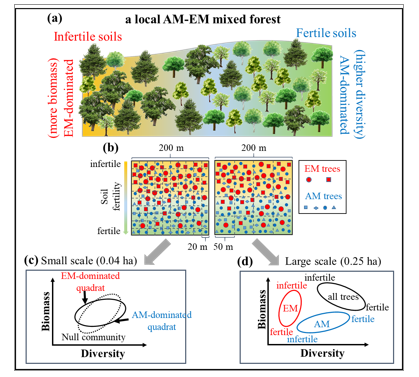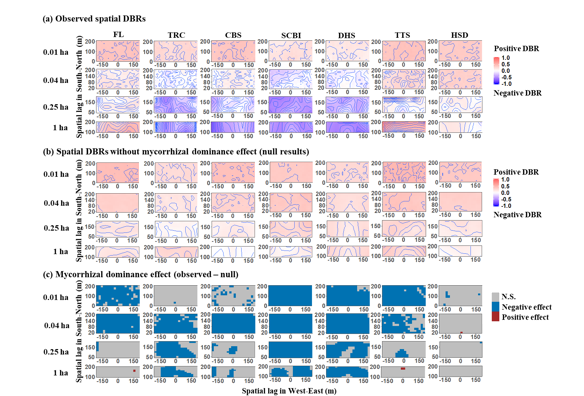New mycorrhizal dominance mechanism drives the scale-dependent biodiversity-ecosystem functioning relationships
The ecological influence of biodiversity loss on ecosystem functioning (i.e., BEF relationships) is currently one of the most vibrant research areas in ecology. In forest ecosystems, however, the BEF relationships usually depend on spatial scales. These scale-dependent BEF relationships are challenging the prevailing BEF theories, and the extent to which findings of BEF studies may be scaled up to inform natural forest management remains debated (see.
In a recent study published in Ecological Monographs, researchers from the Institute of Applied Ecology Chinese Academy of Sciences and their collaborators propose a mycorrhizal dominance mechanism to address the scale-dependence issue in BEF studies (Figure 1). They predicted that the scale-dependent relationships between plant diversity and biomass carbon content observed in natural forests were mostly driven by the distribution patterns of arbuscular- (AM) and ecto-mycorrhizal (EM) tree species, together with soil heterogeneity (Figure 1).
The researchers tested above prediction in Asia and North America regions, via synthesized a “tree species-soil-mycorrhizal traits” dataset in seven forest mega-plots (16-50 ha). Overall, the positive-to-negative shifts in diversity-biomass relationships with increasing spatial scale (Figure 2) were quite common in these forests dominated by AM and EM tree species. Utilizing spatial null models, the researchers further verified that these positive-to-negative relationships were mainly driven by the changes in AM and EM tree dominance (Figure 3), as predicted by the mycorrhizal dominance mechanism.
In theory, although only one function index (i.e., biomass carbon content) has been used in this study, this mycorrhizal dominance mechanism may also yield insights on other ecosystem functions (e.g., biomass production, belowground functions) and therefore supplements new theories into the BEF studies.
In practice, this new mechanism suggests to balance the biodiversity-focused and function-focused conservation schemes, forest managers should pay more attention to the coupling effects of soil conditions and tree mycorrhizal associations, thus yielding new insights on the “selecting suitable tree species for sites” in afforestation and forest management.
This study was supported by the National Natural Science Foundation of China, the Strategic Priority Research Program of the Chinese Academy of Sciences, the Major Program of Institute of Applied Ecology Chinese Academy of Science, the General Program of China Postdoctoral Science Foundation, and the Special Research Assistant Project of Chinese Academy of Sciences.

Figure 1 The mycorrhizal dominance mechanism to explain the scale-dependent diversity-biomass relationships (Image by MAO Zikun)

Figure 2 Scale-dependent diversity-biomass relationships in Changbaishan forests (Image by MAO Zikun)

Figure 3 Spatial null models about the diversity-biomass relationship (DBR) (image by MAO Zikun)



